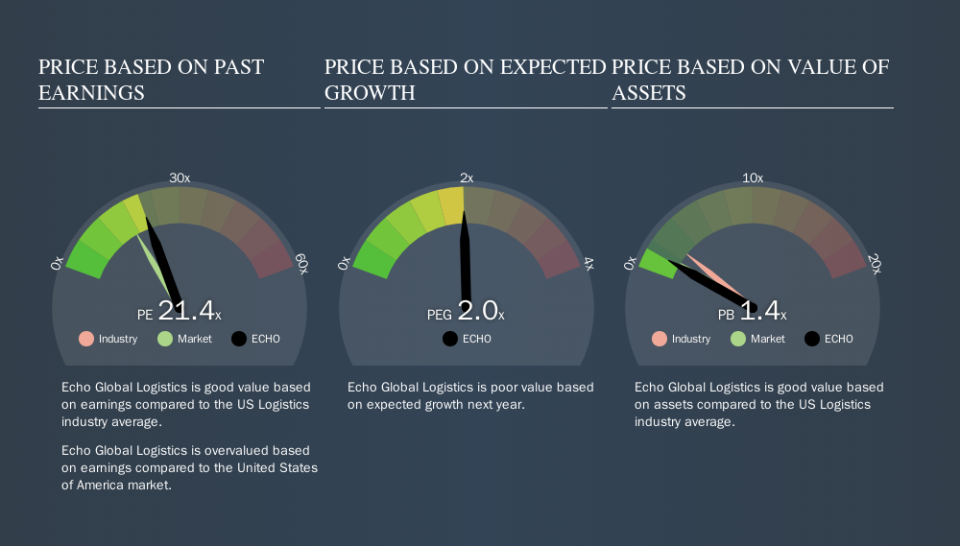Here's What Echo Global Logistics, Inc.'s (NASDAQ:ECHO) P/E Ratio Is Telling Us

Today, we'll introduce the concept of the P/E ratio for those who are learning about investing. We'll show how you can use Echo Global Logistics, Inc.'s (NASDAQ:ECHO) P/E ratio to inform your assessment of the investment opportunity. Based on the last twelve months, Echo Global Logistics's P/E ratio is 21.37. That means that at current prices, buyers pay $21.37 for every $1 in trailing yearly profits.
See our latest analysis for Echo Global Logistics
How Do I Calculate A Price To Earnings Ratio?
The formula for P/E is:
Price to Earnings Ratio = Share Price ÷ Earnings per Share (EPS)
Or for Echo Global Logistics:
P/E of 21.37 = $19.44 ÷ $0.91 (Based on the year to June 2019.)
Is A High Price-to-Earnings Ratio Good?
A higher P/E ratio means that investors are paying a higher price for each $1 of company earnings. All else being equal, it's better to pay a low price -- but as Warren Buffett said, 'It's far better to buy a wonderful company at a fair price than a fair company at a wonderful price.'
How Does Echo Global Logistics's P/E Ratio Compare To Its Peers?
The P/E ratio essentially measures market expectations of a company. The image below shows that Echo Global Logistics has a P/E ratio that is roughly in line with the logistics industry average (21.6).
Its P/E ratio suggests that Echo Global Logistics shareholders think that in the future it will perform about the same as other companies in its industry classification. So if Echo Global Logistics actually outperforms its peers going forward, that should be a positive for the share price. Checking factors such as director buying and selling. could help you form your own view on if that will happen.
How Growth Rates Impact P/E Ratios
P/E ratios primarily reflect market expectations around earnings growth rates. That's because companies that grow earnings per share quickly will rapidly increase the 'E' in the equation. And in that case, the P/E ratio itself will drop rather quickly. Then, a lower P/E should attract more buyers, pushing the share price up.
Echo Global Logistics saw earnings per share decrease by 11% last year. But over the longer term (5 years) earnings per share have increased by 8.7%.
Remember: P/E Ratios Don't Consider The Balance Sheet
Don't forget that the P/E ratio considers market capitalization. So it won't reflect the advantage of cash, or disadvantage of debt. The exact same company would hypothetically deserve a higher P/E ratio if it had a strong balance sheet, than if it had a weak one with lots of debt, because a cashed up company can spend on growth.
Such expenditure might be good or bad, in the long term, but the point here is that the balance sheet is not reflected by this ratio.
How Does Echo Global Logistics's Debt Impact Its P/E Ratio?
Echo Global Logistics's net debt equates to 26% of its market capitalization. While it's worth keeping this in mind, it isn't a worry.
The Bottom Line On Echo Global Logistics's P/E Ratio
Echo Global Logistics trades on a P/E ratio of 21.4, which is above its market average of 17.3. With a bit of debt, but a lack of recent growth, it's safe to say the market is expecting improved profit performance from the company, in the next few years.
Investors should be looking to buy stocks that the market is wrong about. If the reality for a company is better than it expects, you can make money by buying and holding for the long term. So this free visual report on analyst forecasts could hold the key to an excellent investment decision.
Of course you might be able to find a better stock than Echo Global Logistics. So you may wish to see this free collection of other companies that have grown earnings strongly.
We aim to bring you long-term focused research analysis driven by fundamental data. Note that our analysis may not factor in the latest price-sensitive company announcements or qualitative material.
If you spot an error that warrants correction, please contact the editor at editorial-team@simplywallst.com. This article by Simply Wall St is general in nature. It does not constitute a recommendation to buy or sell any stock, and does not take account of your objectives, or your financial situation. Simply Wall St has no position in the stocks mentioned. Thank you for reading.

